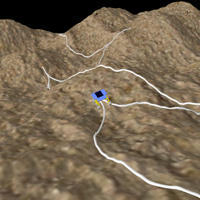
Future robotic missions of planetary exploration will require rovers to navigate difficult terrain with limited human supervision. Current motion planners are unable to automatically generate trajectories for arbitrary boundary states and plan smooth, optimal paths at the regional level which properly reflect rover mobility.
As part of the Mars Technology Program, our project’s research goals are twofold: to develop rough terrain trajectory generation algorithms for local path planning and to produce optimal regional motion planning methods using a constrained search space.
Our first task focuses on the local motion planning problem by extending existing continuous control primitive trajectory generation algorithms for Ackerman vehicle models to generalized rough terrain, actuator and wheel dynamics (e.g. wheel slip), and arbitrary vehicle models. This approach is based on numerically linearizing and inverting forward models of propulsion, suspension, and motion in real time to determine a correct set of parameterized controls given a set of boundary state constraints. Applications for this algorithm include instrument placement, teleoperation, guide path representation, developing differential-constraint aware motion templates, and generating corrective trajectories for path tracking algorithms.
Our second task involves addressing constrained regional motion planning using a lattice-like motion template. We look to generate motion templates which represent a set of feasible motions (subject to the dynamic constraints) while retaining efficiency. As a preprocessing step, a set of controls is created using the trajectory generator described above. These controls are expressed in full configuration space and range across feasible motions of the vehicle. The on-line planner constructs and solves a graph search problem based on this control set, which can be done efficiently due to the prior elimination of infeasible motions. The lattice planner has applications anywhere that planning must be performed for a nonholonomic vehicle in unstructured, cluttered environments. Examples include off-road navigation, and planetary exploration.


